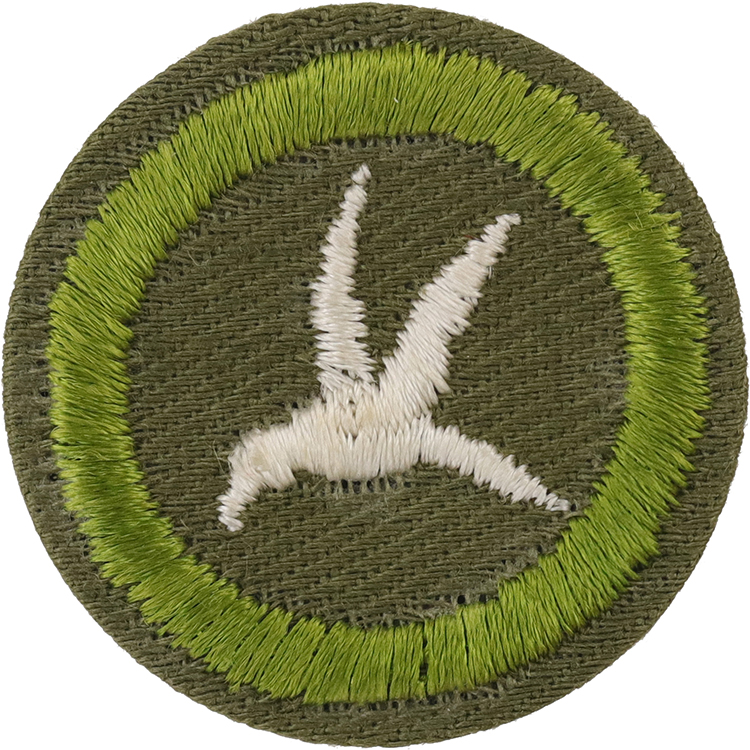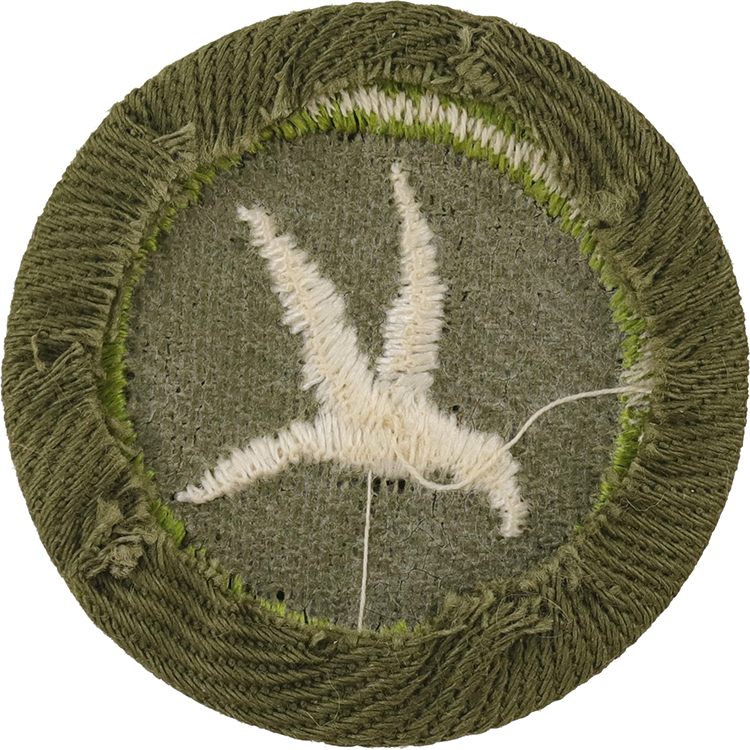
Fig. 1: BirStu-E2-Front
- Cloth: Khaki right twill
- Embroidery: Cotton lock stitch

Fig. 2: BirStu-E2-Reverse
- Back: Plain NO imprint with starch

Fig. 3: BirStu-E2-mve1-front
- Minor variation: Narrow light border

Fig. 4: BirStu-E2-mve1-reverse
- Back: Plain NO imprint with starch
Item Name: Bird Study 1947 - 1960
Item ID: BirStu-E2
Collector Rating: 1
Requirements December 1943 until June 1948
1. Produce a list of forty species of wild birds which have been personally observed and positively identified in the field and tell how to differentiate each from those other species with which it might be confused.
2. Produce a list showing the greatest number of species that he has seen in the field in one week.
3. Produce a list derived from personal reading of:
a. Twenty species of birds particularly noted for their value to agriculture in the destruction of insects and weed seeds.
b. Ten birds of prey particularly useful in the destruction of rats and mice.
c. Ten species of fish-eating birds, and tell why they are not inimical to man's interests.
4. Describe at least two bird boxes and two food tables that have been erected by him.
5. From personal observation name and describe the birds he has seen in three different habitats (open fields, woodlands, farmland, marsh, etc.) and tell why all birds do not choose the same habitat. Make at least three visits to each type of countryside.
Make a census of the bird-life of a 25-acre tract by systematically covering the ground on three separate days and listing the species and number of individuals of each observed.
6. State what he did to protect birds from slaughter; and to promote the creation of bird preserves and sanctuaries.
(BIRD STUDY IN HAWAII)
Since it is impossible for Scouts on the Hawaiian Islands to meet the requirements in Bird Study, as the required number of birds is not to be found on the Islands, these requirements are official for use in the Hawaiian Islands only, but in no other section.
1. Tell approximately:
(a) How many different species of wild birds are to be found in the Hawaiian Islands.
(b) How many are found nowhere else in the world.
(c) How many were introduced by man.
2. Give the common English or Hawaiian name of ten birds which he has personally observed Hawaii, five of which are forest birds and at least two of which are sea birds. Tell something of the size, coloring, habits and food of each.
3. Produce a list of twenty introduced birds which are found at large in the Hawaiian Islands. Tell the country from which came,and whether it is chiefly beneficial or harmful to man's interests, and why.
4. Produce a list derived from personal reading of:
(a) Ten birds particularly noted for their value to agriculture in the destruction of insects and weed seeds.
(b) Ten birds of prey particularly useful in the destruction of rats and mice (include at least three island birds of prey).
(c) Ten species of fish-eating birds and tell something of their habits.
Name those in each group which are found in Hawaii.
5. State what is done in the Territory of Hawaii in the way of bird protection and know in general the bird protection laws and penalties for breaking the laws. Describe the location and purpose of the Hawaiian Islands Bird Reservation. Name the bird societies in Hawaii and state what they are doing for bird protection.
6. Name and describe five birds which are very rare or extinct in the Hawaiian group. Tell what has caused this.
7. Tell what he has done to persuade others to refrain from destroying bird life; OR produce evidence of some constructive piece of work which he has done to protect bird life in Hawaii.
Requirements June 1948 until January 1965.
1. Produce a list of forty species of wild birds which have been personally observed and positively identified in the field and tell how to differentiate each from those other species with which it might be confused.
2. Produce a list showing the greatest number of species that he has seen in the field in one week.
3. Produce a list derived from personal reading of:
a. Twenty species of birds particularly noted for their value to agriculture in the destruction of insects and weed seeds.
b. Ten birds of prey particularly useful in the destruction of rats and mice.
c. Ten species of fish-eating birds, and tell why they are not inimical to man's interests.
4. Describe at least two bird boxes or a bird bath, and two feeding stations that have been constructed and erected by him.
5. (a) From personal observation name and describe the birds he has seen in three different habitats (open fields, woodlands, farmland, marsh, etc.) and tell why all birds do not choose the same habitat. Make at least three visits to each type of countryside; OR (b) make a census of the bird-life of a 25-acre tract by systematically covering the ground on three separate days and listing the species and number of individuals of each observed.
6. State what he did to protect birds from slaughter; and to promote the creation of bird preserves and sanctuaries.



